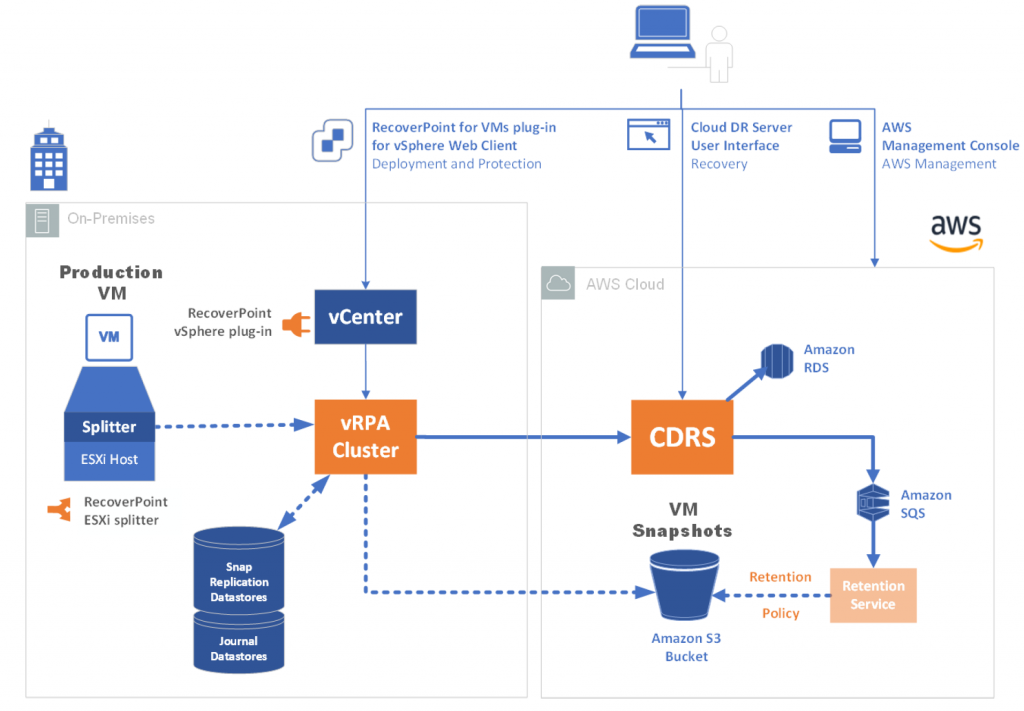RecoverPoint for VMs 5.2.1 was released last month on January 24, 2019 and brings the ability to replicate VMware VMs to AWS for DR. This has been something we have been looking forward to for a long time.
In the new update, RP4VMs is able to replicate change deltas (snapshots) to AWS S3 every 15mins. Customers can combine replication to AWS as well as replication to their own on-premises VMware environment. This allows for multiple copies to the cloud and either local or remote on-premises environments. The best part is, RecoverPoint for VMs Cloud DR is a free feature with no additional licensing cost for existing RP4VM customers. You just need to pay Amazon for the S3 storage and any EC2 instances you use to spin up the VMs.
The main components of RecoverPoint for VMs Cloud DR are:
- On-premises:
- Standard RP4VM deployment, including vRPA cluster, splitters and vCenter plugin
- RP4VMs replicates directly to S3 (sending snap-based virtual disk segments)
- RP4VM automatically deploys the Cloud DR Server (CDRS) and communicates protected VMs meta-data
- Cloud:
- The CDRS runs 24/7 to manage cloud copies and provide in-cloud access for DR orchestration, monitoring and recovery operations
- Restore services are launched by the CDRS for managing cloud copies retention (once a day) and rehydration (on-demand for recovery operations). Restore services can automatically scale out to manage high capacity of tasks

There are three main benefits of RecoverPoint for VMs with Cloud Disaster Recovery:
- Ease of Use
- Management: Configure and protect directly from vCenter
- Deployment: Cloud DR Server (CDRS) automatically deploys when RecoverPoint for VMs registers in the AWS and handles all cloud operations
- Monitoring: The CDRS UI handles monitoring and recovery
- Cost-effective
- No additional licensing required
- Low cloud cost (copies on AWS S3, restore services on demand)
- VMware Cloud SDDC runs on demand when recovery is needed
- Space-efficient (proprietary snapshot-based replication; tracks only changes after taking a full snap copy; consolidates to cloud according to the retention policy)
- Industry leading technology
- Proprietary snapshot-based replication delivers RPOs measured in minutes
- Multiple copy options available for cloud and on-premises (remote/local)
- Flexible restore (recover to VMware Cloud or to an EC2 instance)
- Cloud DR orchestration (automated Test, Failover and Failback flows with multi-VM pre-configured DR plans)
- RTOs measured in minutes when recovering to EC2 instances using Rapid Recovery copies
As for now, RecoverPoint for VMs 5.2.1 supports vSphere version 6.0U2 and later (including 6.7U1), as well as version 6.5 with the vCenter Web client. Earlier vSphere versions might be supported by earlier RecoverPoint for VMs releases. Rumor has it that Azure is most likely the next cloud environment that RecoverPoint for VMs will support in a later release.
For details on how to install and configure RP4VMs on AWS Dell EMC provides a detailed (and I mean 149 page PDF kind of detailed) document on their Solve Online tool, which is available to all Dell EMC customers and partners.